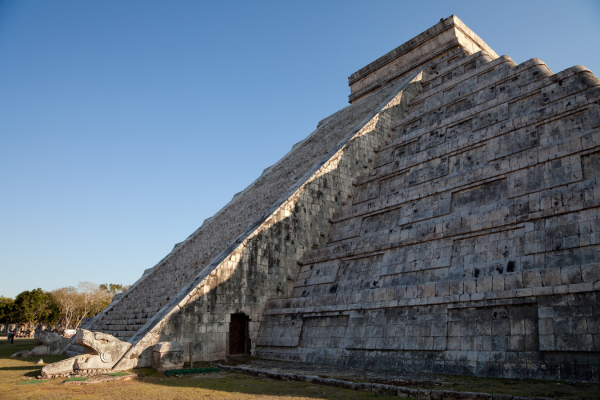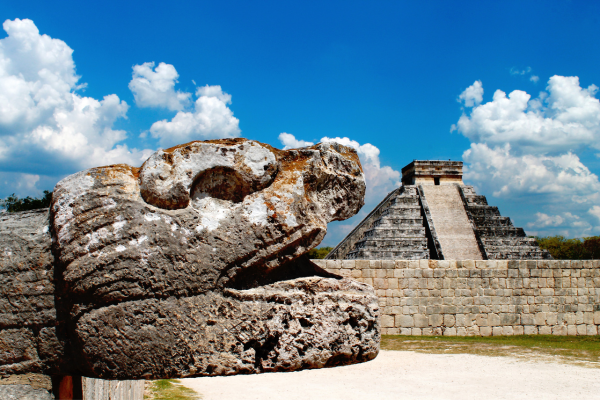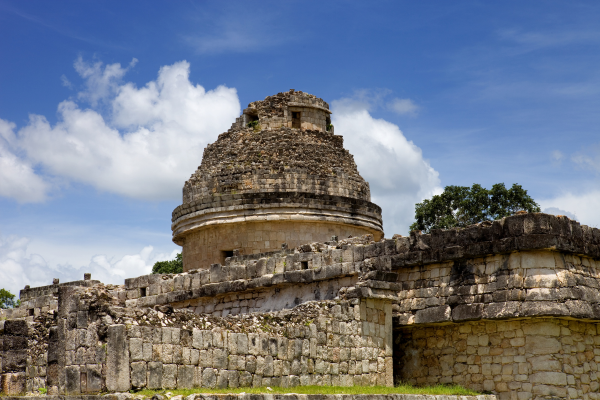MEXICO
The Wonder of Chichén Itzá
By Sandra Rodriguez and Aleczandra Garza
San Antonio, TX, United States
One of the most popular tourist sites in Mexico is the great Mesoamerican city known as Chichén Itzá. Built hundreds of years ago, Chichén Itzá is about 120 miles from Cancún on the Yucatán Peninsula. In a 2007 online poll, millions of voters chose these stone ruins as one of the seven wonders of today’s world, along with locations like the Colosseum in Rome and the Great Wall of China.
History
Chichén Itzá in Maya means “at the edge of the well of the water magicians.” Nobody is certain when the area was first settled, but historic accounts have dated it as far back as the fifth century CE. By approximately 600 CE, it had become a major economic and political power. Eventually its dominance waned, so that by the time the Spanish conquistadors arrived in the 16th century, it had been abandoned.
There are two main sections within the site’s four-square-mile core:
- Chichén Viejo (“Old Chichén”)
- Chichén Nuevo (“New Chichén”)
The older part contained homes for the elite, while the newer buildings served as temples, observatories, tombs, etc. As many as 50,000 people are estimated to have lived in the entire metropolis during its peak in the 10th through 13th centuries.
Archaeoastronomy
An early calendar system was devised by the Olmec civilization, which existed from approximately 1400 BCE to 400 BCE in what is now Mexico’s Gulf Coast region. The Maya refined the calendar using their knowledge of astronomy and mathematics. They also built monuments that observed and honored the motions of celestial bodies, including Venus, the sun, and the moon.
The Maya’s extensive understanding can be seen in the design of the tallest structure in Chichén Itzá, the Temple of K’uk’ulkan (or Kukulkan). Named after a snake deity and known locally as El Castillo (“the castle”), the pyramid stands almost 100 feet tall and has 91 steps on each of its four sides.
Adding all of the steps together with one more to reach the platform at the top, you get a total of 365, the same number as days in a year. The Mayan calendar is also encoded in the number of terraces and carved panels. Additionally, at each equinox, a light-and-shadow display resembles a serpent slithering down the side to connect with an enormous snake head on the ground.

Visiting
The best months to visit Chichén Itzá are November through April when the weather is cooler and drier. If you were pressed for time, you could complete your tour in around three hours, but it usually takes longer.
The location is open most days of the week from 8 AM to 5 PM, and tickets are available on site. You can customize your visit with many different experiences available for purchase, so there are a variety of price points.
The basic ticket, which includes lunch, costs US$85 for adults and US$74 for children. The most expensive visit gives you and two other passengers an aerial view of the entire area. You’ll pay US$3,014 to tour Chichén Itzá by plane.
Bottom Line
While visiting Chichén Itzá is an amazing experience that gives visitors a window into history, it is important to know what is expected. For example, climbing the stairs of the Temple of K’uk’ulkan is prohibited. This rule was implemented in 2008 because of concern over damage to the structure and injuries to tourists.
Despite the ban, sometimes visitors make the climb anyway. They are usually met with angry jeers from the nearby crowd and, once they’re back on the ground, detained by local authorities. The maximum fine for climbing the steps can be as high as 50,000 pesos, which equals about US$2,800.
Chichén Itzá contains a rich history of ancient Maya culture, has aged wonderfully, and contains multiple archaeological sites. So if you are planning on visiting this amazing place, make sure to know the rules and do your part in preserving the magic for others to enjoy for years to come.
Have a suggestion for this story? We’d love for you to submit it!


Blank
Blank
Math Resources
- The Temple of K’uk’ulkan has four equal sides. Each side has 91 steps with the platform creating an extra step to make 365 total. If there were 397 days in a year, how many steps would you expect to find on the sides?
- What would be the final price for the basic tour if a family of two adults and three children visited Chichén Itzá? What would it cost if the next day they wanted to visit by airplane?
- The central core of Chichén Itzá occupies an area of four square miles. If one square mile equals 484 football fields, how many football fields would be able to fit in the area where Chichén Itzá is located?
- Pretend your birthday is on February 29. This date only occurs once every four years on what is known as leap year. How old would you be right now if your birthday was every four years? On what day would you choose to celebrate your birthday in the non-leap years?
Social Justice Question
In the early 20th century, Chichën Itzá was primarily viewed as a “lost city” of the ancient Maya, so archaeologists focused on restoring the ruins to their original form. However, as more research was conducted and the rights of Indigenous peoples became more widely recognized, there has been a shift toward interpreting the site through the perspectives of the modern Maya communities that still live in the region. Why do you think it is important to include the voices of the local Maya people?
Explore Further
- Quick facts for kids
- HD and laser images of some structures
- UNESCO World Heritage List description
- Time-lapse video of the equinox shadow display
Share Your Story
Write your own Global Math Story and send it to us!
Sorry, the comment form is closed at this time.